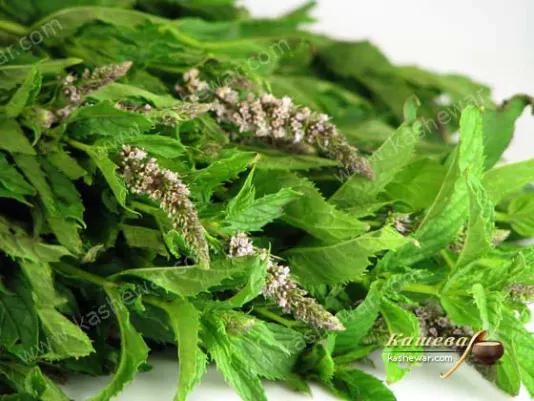Yogurt Dessert with Rum
Yogurt dessert with rum is a Spanish recipe that is prepared at least 2 hours before serving.

Mint is an aromatic herb that I often use to create balance in dishes. Its fresh leaves contain essential oils that bring coolness and make heavy ingredients easier to perceive. Over years of practice, I realized that mint works wonderfully in various culinary directions: from light summer salads to hot drinks that warm you in winter. Its use is versatile: it pairs with fruits, vegetables, legumes, and meat. At the same time, mint is very delicate and doesn’t tolerate overuse. If added excessively, the aroma becomes sharp and unpleasant. That’s why I always follow the rule: better less than more. It retains its value even after slight heating, but is most expressive when fresh. Its properties are not only culinary – it supports good digestion and brings a feeling of lightness after a hearty meal. For me, mint is an ingredient that creates a sense of completeness and purity of taste.
Over years of cooking, I’ve learned to recognize quality mint at first glance. Fresh leaves have a rich green color without yellowing or dark spots; they are firm and aromatic. If the leaves are wilted or have dry edges, that mint has lost part of its qualities. I always choose bunches with a clean, refreshing smell: it should be soft, not harsh. At the market, I check the stems: they should be strong, not brittle. I realized that mint loses freshness quickly, so I buy it in small portions and use it right away. If I need to keep it longer, I place the sprigs in water like a bouquet and cover them lightly with a bag. This way, the leaves stay fresh for a few days. In the refrigerator, mint keeps well in a container with a damp napkin. I never take mint with signs of rot or foreign odor – such can spoil a dish. In my practice, the right choice of this ingredient always ensures a quality result.
I always start working with mint by thoroughly rinsing it with cold water to remove dust and possible impurities. Then I carefully pat the leaves dry with paper towels, since excess moisture shortens storage time and worsens texture. If needed, I separate the leaves from the stems, as they hold the most value. In my practice, I often freeze mint: I chop the leaves and place them into ice cube trays with water or oil. This way, it keeps its aroma and is ready for later use. Another method is drying. I tie sprigs and hang them in the shade with good ventilation, then store them in glass jars. Such mint has a milder taste but works great for teas or sauces. Experience shows: you shouldn’t dry mint at high temperatures, as it loses its essential oils. I also learned to store it as puree in the freezer, mixing it with a bit of lemon juice. This helps when I need to quickly add a refreshing note to a dish.
Over years of practice, I have confirmed: mint shows itself best fresh but sometimes requires minimal heating. If added at the beginning of boiling, the aroma disappears, leaving only a weak note. That’s why I always add the leaves at the end of cooking – in soups, sauces, or drinks. When baking or braising, I use mint carefully: I wrap a sprig in parchment with other herbs so the aroma unfolds gradually. It is very important not to overheat the essential oils – they break down with prolonged high temperatures. Mint works wonderfully in cold dishes: salads, smoothies, and desserts preserve its natural flavor. I also use mint to flavor oils or syrups by gently warming them over very low heat and cooling immediately. This keeps the bright profile. I always remember: mint is not a base ingredient but an accent, so I add it at the end and in the right amount.
In my practice, mint has always been a universal partner. It pairs beautifully with citrus – lemon, lime, orange – enhancing their tartness. With berries, especially strawberries and raspberries, it creates a feeling of lightness and freshness. In meat dishes, mint balances fattiness: I use it in sauces for lamb or pork. With vegetables like cucumbers or zucchini, it adds a pleasant coolness. I realized that mint works best in sauces: a yogurt sauce with mint is always a winning option for summer dishes. It also suits drinks: tea, lemonade, or even warm milk with mint have a calming effect. In desserts, the combination of mint and chocolate creates an unmatched flavor balance. It is important to remember that mint has a strong aroma, so I add it in small portions to avoid overshadowing the main product. Over years of cooking, I’ve seen: mint is the note that makes a dish lively and interesting.
The most common mistake I’ve encountered is adding too much mint to a dish. Its aroma quickly overwhelms other ingredients and makes the taste sharp. That’s why I always add mint gradually, tasting as I go. Another problem is improper storage: fresh leaves wilt quickly without moisture, and when left open in the fridge, they absorb foreign odors. I always keep it in containers or covered. Another mistake is adding mint at the beginning of cooking: then the aroma disappears completely. In my practice, I’ve also seen people drying mint in the oven at high temperatures – this destroys its value. That’s why I always choose natural methods. Safety matters too: mint can cause discomfort if consumed excessively, especially in children. I always advise using it in moderation and considering individual sensitivity. Experience shows: respect for this ingredient ensures it becomes a highlight, not a problem, in a dish.